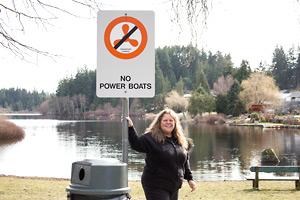Cranberry Lake is dying and City of Powell River council is still uncertain whether there is anything that can be done about it.
In a letter dated January 31, 2014, from Rolland Miller on behalf of Cranberry Ratepayers Association, Miller called the lake a gem in the middle of town and reminded council that it was once a popular recreation swimming spot. In addition to providing refuge for many nesting birds and waterfowl, it is the only body of water on the Upper Sunshine Coast to have a confirmed population of endangered Western painted turtles. He brought up a previous request for council to take immediate steps toward restoration that had not yet been addressed.
Factors believed to be contributing to the lake’s demise are a species of Nymphaea, an ornamental water lily not native to British Columbia, and the main fresh water source being cut off when the city tapped into Haslam Lake to supply water to the community. Since that time, the lake has been fed by small streams and runoff.
At the committee of the whole meeting on March 20, councillor Debbie Dee reminded the committee of the limited lifespan the lake had been given and that there was a narrow window of opportunity. “Four or five years ago we had 12 or so years left in Cranberry Lake,” she said. “The problem is still there.”
Dee asked whether water could again be pumped from Haslam into Cranberry. In response, Frank D‘Angio, manager of engineering services, said it would mean water would first have to be de-chlorinated, which posed numerous challenges for engineering staff. Dee asked whether during the process of re-doing the lines into the Haslam Lake reservoir a duplicate line bypassing the reservoir could be constructed to pump fresh water directly into the withering body of water. This way the cost of de-chlorination could possibly be avoided.
Mayor Dave Formosa said that the cost associated with building the extension would come with an approximate $2 million price tag. “Is it worth $2 million?” Formosa asked. “It’s probably worth $10 million. We just need to know what we’re getting ourselves into. I would like nothing more than to save Cranberry Lake.”
Formosa indicated he was not optimistic that the lake was going to be rejuvenated by simply pumping fresh water in. “I don’t feel confident supporting the motion. We tried some time ago, you and I, Debbie, and it seemed like a lost cause.”
Miller’s letter also mentioned a petition that was signed and presented at the ratepayers’ meeting in January, concerning a disruption of sensitive bird habitat. The residents say they were threatened by several individuals in a group of people who were racing small electric and gas radio-controlled boats on a course at the northern end of the lake, close to Lindsay Park. The concerned residents reported that the boats are capable of reaching speeds of up to 40 miles per hour and are scaring nesting birds in the area. The boat racers said that they have permission to race on the lake and are refusing to stop.
Dee, in a somewhat fueled support of her position, said, “If we’re not going to do anything they might as well just let the speedboats race on the lake and kill all the swans, and run over the turtles, or we can just fill it in. Let’s just make a choice.”
Formosa asked if part of the solution might be in raising a society to save Cranberry Lake. “We need to know what the issues are that led up to the issues currently facing the lake.”
In a conversation after the meeting, Thomas Knight, manager for the community energy and emissions plan for the city, suggested a situation similar to the Cranberry Lake issue took place in Vancouver. In 2012, Associated Engineering, a firm with branch offices across the country, released a report after it was hired to devise a plan to restore Burnaby Lake. The lake had deteriorated over a period of 30 years due to natural infilling and sedimentation. A detailed, precedent-setting plan was drafted by following strict dredging and dewatering environmental guidelines and by reusing existing sediments to stabilize the lake ecosystem. The lake, and its resident species, were successfully restored. The consulting firm won several awards for its work.



